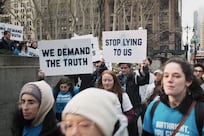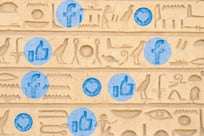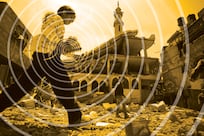Residents of Nabi Saleh in the West Bank have been demonstrating, each week for the past two years, against the slow encroachment on their land by Israeli settlers.
Gathering in the village centre on Friday afternoons, villagers along with Israeli and international activists attempt to march, under the watchful eye of soldiers, to a disputed agricultural spring which was confiscated recently by Israeli settlers.
Often protesters never even reach the edge of the village; crowd-control measures by the military regularly include barrages of tear gas and rubber bullets.
Palestinian villagers claim that hundreds of protesters have been injured, some seriously, in the Nabi Saleh demonstrations.
But no one had been killed there - until last week.
The death of 28-year-old Mustafa Tamimi may seem to have little in common with the more numerous deaths of protesters in Cairo over the past few days.
Indeed the demonstrations are different from each other in many ways. But in protests from Tunis to Cairo to little Nabi Saleh, the use of tear gas by authorities, and the increasing number of related fatalities, has become a common thread in recent months.
Mr Tamimi's injuries occurred amid a fairly common occurrence in the West Bank: protesters were throwing stones at armoured Israeli vehicles. As the demonstration slowed towards the end of the day, one Israeli jeep stopped as it was making its way out of the village.
The vehicle's back door opened wide enough for a tear-gas launcher, known to Israeli soldiers as a "ringo", to fire a single canister of the gas.
Mr Tamimi, who was standing three metres behind the jeep, was hit directly in the face by the canister. The next morning he was pronounced dead in an Israeli hospital near Tel Aviv.
Mustafa Tamimi was the 20th Palestinian protester killed by the Israeli army in the last eight years of unarmed West Bank demonstrations, according to the Israeli human rights group B'Tselem. Many of the deaths have resulted from the negligent and unlawful practices of Israeli soldiers.
Israeli army regulations stipulate that soldiers are not allowed to fire tear-gas canisters directly at protesters, since doing so can turn sublethal crowd-control devices into deadly instruments of war. There are also allegations that protesters in Cairo were killed just by inhaling the gas.
Palestinians have opened court cases over violations of the Israeli regulation, but no case has resulted in the prosecution of soldiers. To make the situation more frustrating for Palestinians, Israeli soldiers often demonstrate extreme restraint when dealing with Jewish settlers who riot whenever an illegal outpost draws the army's attention.
In 2009, Bassem Abu Rahman was killed instantly when an Israeli soldier fired a tear gas-canister directly at him from close range during a demonstration against the separation barrier in the village of Bil'in.
Then, last January, Jawahar Abu Rahmah, Bassem's sister, was killed in the same village after prolonged exposure to tear gas used to disperse demonstrators. And an activist from the United States, Tristan Anderson, was left paralysed after he was hit directly with a canister during a demonstration in the village of Ni'ilin in 2008.
US companies like the Pennsylvania based Combined Systems Inc (CSI) are among the primary suppliers of tear gas used in the West Bank. After Jawahar Abu Rahmah died as a result of breathing CSI tear gas in Bil'in, a number of pro-Palestinian advocacy groups staged protests and launched a boycott of the company. CSI officials have remained silent on the use of their product by Israeli forces.
One important consequence of this year's Arab revolutions has been renewed interest in the use of US-made tear gas to control social protests across the Middle East.
A number of US tear gas manufacturers have ramped up production, while profits have been soaring as governments from Bahrain to Egypt demand more and more tear gas to suppress political revolt.
The result has been deadly. In January, the 32-year-old French photographer Lucas Mebrouk Dolega was killed by a tear-gas canister fired at close range by Tunisian police. And hundreds of protesters in Egypt have claimed that tear gas canisters made by CSI were fired at them, often at close range, by security forces.
According to the leading Egyptian daily Al Ahram, port officials in Suez recently protested against unloading a shipment of CSI-manufactured tear gas destined for the Supreme Council of Armed Forces in Cairo.
Amnesty International has joined the port officials' protest, issuing a sharply worded statement singling out the use of CSI tear gas in Egypt, and calling on the US government to stop approving sales of the product to Egypt because of its misuse against protesters.
Tear gas has become the main instrument by which authoritarian regimes control social protests that challenge their power in the Middle East. Used tear-gas canisters litter the streets of Cairo and Tunis. Identical canisters allow the Israeli army to crush unarmed demonstrations throughout the West Bank, without attracting widespread condemnation from the international community.
What seems certain is that until tear gas is viewed as the deadly weapon it can be, authoritarian governments will continue to use it with impunity.
Joseph Dana is a journalist based in Ramallah




